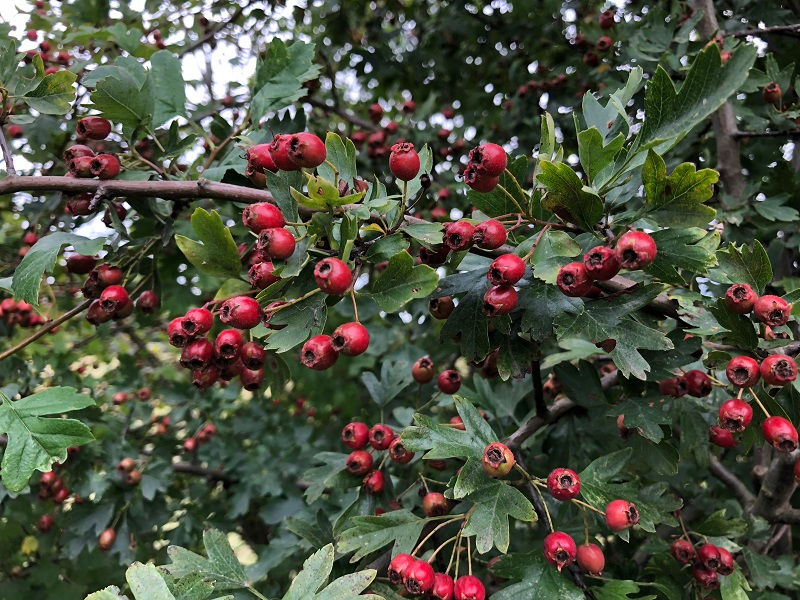Hawthorn - Crataegus monogyna
- The Foraging Course Company
- Jan 22
- 3 min read
Updated: Feb 3

Edible tree - novice Season - present all year. Flowers: late spring. Fruit: summer - autumn Common names Hawthorn, common hawthorn, Mayflower, May, one-seed hawthorn, single-seeded hawthorn, English hawthorn, quickthorn, whitethorn
Scientific name meaning: The binomial nomenclature is of Greek origin. Crataegus comes from two words: Kratos, meaning strength, and Akis, meaning sharp. Monogyna means one pistil. The pistil is the female part of the flower.
Habitat  Hawthorn is a tree and can be found in woodland and as individual specimens but it is most commonly found in farmland hedgerows. It can tolerate most soils except those that are nutrient poor. It is native to Britain and can be found across Europe. |
Overall structure  Hawthorn's canopy forms as a mass of twisted, thorny branches that can reach the floor. In hedgerows, it is often trimmed back or laid, giving it a neater appearance than when it is left to grow naturally. |
Leaves  The leaves emerge in early spring when they are shiny and pale green. The age to a deeper green with a more matt texture. The leaves are deeply pinnately lobed, similar to an oak tree, and have five distinct lobes. |
Trunk and branches  The trunk of hawthorn is pale brown and looks dry, cracked an aged even on very young specimens. The younger twigs are a darker brown and covered in sharp thorns that can reach several centimetres in length. |
Flowers  Flowers appear around May, giving the tree one of its common names, and are white or pinkish with five petals. The pollen bearing anthers at the tip of the male reproductive parts are pink-purple when the flowers first open but mature to brown. The aroma is sickly sweet and honey-like to some but rather unpleasant to others. |
Fruit  The fruit of the hawthorn is a pome (having a core containing the seeds) and called a haw or haw berry. They are red fleshed when ripe - from late summer - and contain one large seed. |
Possible lookalikes  Many hawthorn species, like the one pictured, look similar but these are also edible. When Hawthorn is in flower or naked (in winter), it could be confused with blackthorn (Prunus spinosa). However, blackthorn flowers before its leaves, which are oval, appear - usually in early to late March. Hawthorn's leaves, which are deeply lobed, appear before its flowers. |
Use as a food The young green leaves have a mild nutty taste and can be used as a salad leaf. Syrups, cordials, preserves and infusions can be made with the flowers, which should be collected when sweet smelling.
The berries, or haws, are extremely high in pectin and therefore particularly useful for making jams, jellies, sweets and fruit leathers. They can also be used in chutneys, liquours, and wine making, and make hawthorn ketchup.
If dried, the flesh of the of the haws can be powdered and used to make hawthorn bread.
The flowers, leaves and berries can all be used to make a herbal infusion Use in herbal medicine and medicine Hawthorn contains bioflavonoids and is considered to be extremely valuable in herbal medicine for the treatment of cardiac and circulatory ailments. It has traditionally been used in the treatment of angina, poor circulation, hypertension, cardiac muscle weakness, blood pressure disorders, arteriosclerosis, and blood vessel narrowing, and as a sedative, diuretic and antispasmodic.
The leaves, flowers and berries are all used in tinctures, decoctions, and infusions, and as food supplements. The bark has also been used to treat malaria and fever
If you are suffering from any ailment or need medical advice, please see your General Practitioner.
Hazards Like apples, the seeds of hawthorn contain a cyanogenic compound called amygdalin so should not be consumed
Other uses Hawthorn makes excellent thick hedging and recovers well from very heavy pruning. It has long been used to keep stock in and thieves out.
It is a hard wood meaning it is good for making handles for tools Importance to other species Very important for pollinators, nesting hedgerow birds, and as a food source for native and migratory birds
Always stay safe when foraging. You need to be 100% sure of your identification, 100% sure that your foraged item is edible, and 100% sure that you are not allergic to it (it is good practice to always try a small amount of any new food you are consuming). If in doubt, leave it out!




Comments